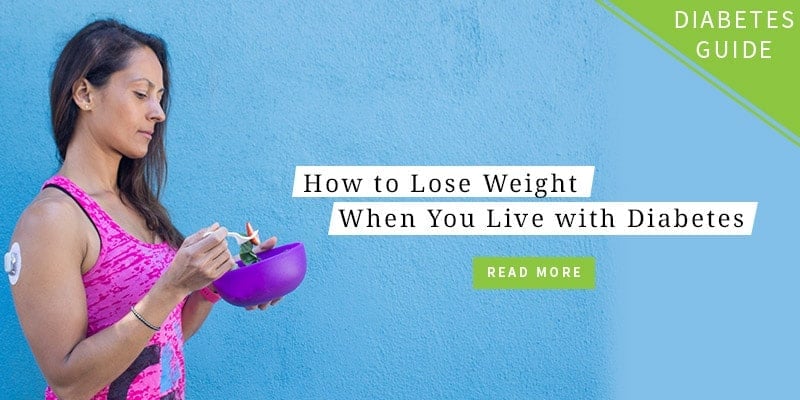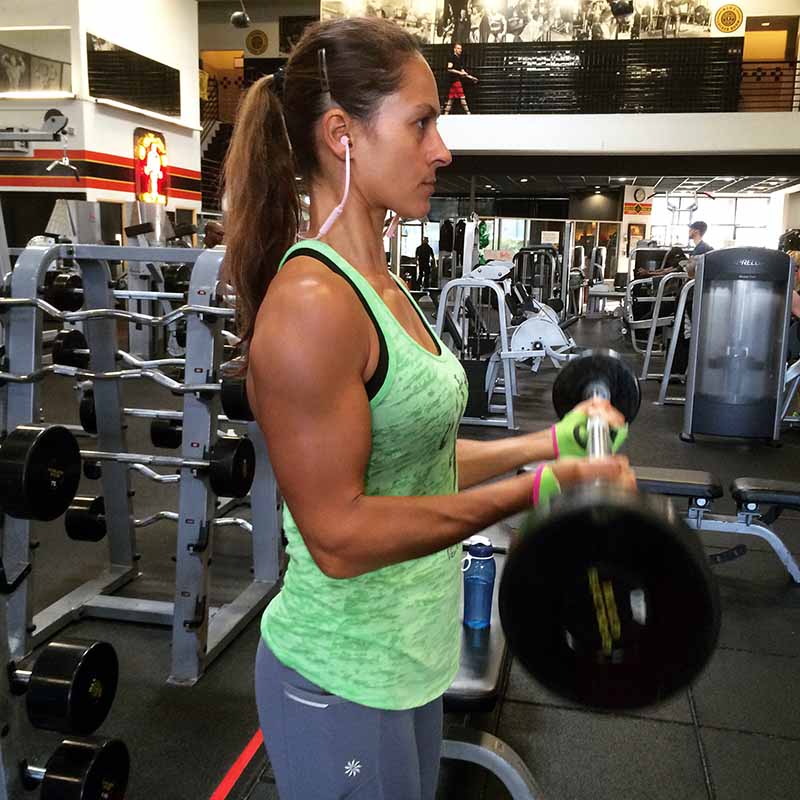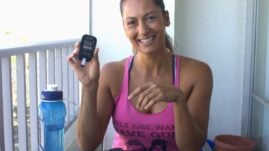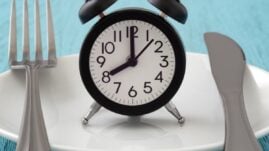Losing weight can be difficult for anyone, and living with type 1 diabetes definitely doesn’t make it easier. However, there ARE people who set out to lose weight and end up so extraordinarily successful that you wonder if they have some inside information you don’t.
That information EXISTS. I’m here to give you the rundown on how to lose weight with type 1 diabetes (actually, most of the advice is relevant for people with any type of diabetes).
Without further ado…let’s GET TO IT!

Temper expectations at the start
Most people have this intense need for instant gratification. They want that 15 lbs gone by yesterday! While I’m all for efficiency, I’m going to be short and sweet and show reality with a pop quiz:
True or false: it took more than a week to gain the weight you are trying to lose.
The answer is undeniably “True”. So if it took you X number of months to gain weight, why would it take you a week or two to lose it?
It doesn’t. It takes time and some concerted effort. Don’t expect to lose all of the weight immediately, but know that with proper habit formation and consistency, you WILL see the results you are after.
The general rule for healthy weight loss is to aim for A MAX of 1-2 lbs. per week.
It’s also quite common for people living with diabetes to take as long as 2-3 weeks before seeing any weight loss at all on a new diet.
“Why?” you ask.
Changing caloric intake and workout routines may require a reduction of insulin (or other diabetes medication) as well as diet manipulation, which takes a little trial and error to adjust.
BE PATIENT.
Once the ball is rolling, a slow and controlled weight loss makes it much more likely that the weight will come off and STAY off than if you crash dieted and lost a lot of weight quickly.
To learn more about setting realistic goals, read “How to set Realistic Diabetes and Fitness Goals and Find Your Positive Motivation”.
How many calories should you eat?
Weight loss can be summed up as follows:
Calories in (eating) < Calories out (burning) = weight loss.
From a thermodynamics standpoint, if you are eating fewer calories than you are expending, you should THEORETICALLY lose weight. No system is perfect, but this is the general premise.
However, this whole “eat less than you expend” advice gets blown out of proportion quite often as you see people slashing their diets to nearly nothing or eating just grapefruits all day. This will work in the very short term, but will seriously decrease your metabolism while you mostly lose water weight that will come right back when you finish your diet.
The first step in any weight loss program is, therefore, to calculate how many calories you should eat per day for a healthy weight loss.
Luckily, there is a guide here on Diabetes Strong that explains how to do this in 5 easy steps. So before reading on, please go to “How to Find Your Daily Calorie Need” and calculate your daily calorie need. Then come back here and continue this guide.
How about protein, carbs, and fat?
I’m not going to stand here and tell you that there is only one way to lose weight with type 1 diabetes. I’ve had experience losing weight on a high-carb diet, low-carb diet, and moderate-carb diet.
They’re all predicated on the aforementioned “calories in, calories out” equation.
But, a couple of tips to consider as you plan your diet:
Protein is helpful in satiety AND retaining muscle mass
In other words, protein will help keep you fuller for longer after meals, which is key in a situation where you are eating less than you may be accustomed to normally.
Additionally, when people lose weight, the composition is typically 75% fat and 25% muscle1. However, a higher protein diet has been linked to a reduction in the amount of muscle lost during a caloric deficit.2
I could go on and on all day, but I’ll leave you with this:
Recommendation: Aim to eat 0.5-0.8 grams per pound of bodyweight per day. It will help you keep your hard-earned muscles while losing weight. So if you weight 200 pounds (91 kg), you should aim for 100-160 grams of protein per day.
Note: If you suffer from kidney disease or have any history of kidney problems, increasing your protein intake may not be recommended.3 Always consult your medical team before making major dietary changes.
Carbs and Fat are FRIENDS (and food)
So many people fear fat and carbs. It is too bad people won’t give them a chance and get to know them…
…and recognize that there is NOTHING scary about them, they deliver a great deal of benefits, and they are delicious!
Carbs are great for those quick bursts of energy you need during a workout. They also provide fiber, which is critical for digestive health and increasing satiety.
Fat will come in handy during a long, sustained workout as the primary energy source. Fat also provides omega-3s, which are useful for anti-inflammatory effects as well as visual acuity, and additionally is the building block for hormones, like testosterone and estrogen.
The keys are the sources from which you get them. Try to stick to the whole food, lesser processed varieties of fat and low-glycemic carbs, rather than the Frankenfoods that have been sitting on the shelf at the grocery store for ages.
The other key is HOW MUCH of each to eat.
At the end of the day, it truly comes down to what works best for you and your blood sugar management. Maybe fewer carbs work for you but more carbs work for me.
But, after determining calorie and protein needs, try to partition the remaining calories pretty evenly for fat and carbs.
For example, if your calorie requirement is 2000 per day and your protein needs require 800 calories, try to split the remaining 1200 calories evenly between fat and carbs (600 calories each) and work from there to determine the optimal amount for you and your goals.

Exercise is great, but nutrition is the key
Raise your hand if you’ve heard the saying “You can’t out-train a bad diet.”
Maybe you’ve heard it, maybe not. Either way, it is very true. It’s really difficult to overcome a poor nutritional intake. Really, REALLY difficult.
Don’t get me wrong. Exercise is CRUCIAL for a healthy lifestyle and for a successful weight loss initiative. It provides a ton of benefits that otherwise wouldn’t be attainable. But, in isolation, exercise alone will not result in as much weight loss as dieting will.4
However, what if we…dare I say it…utilize BOTH?
Both anecdotally and in the research, combining diet and exercise will result in the best outcomes while also setting you up for sustained success, as ideally, this weight loss should kick off a lifestyle change.
How much should you exercise, and what type of exercise?
If you are just starting out, you don’t want to go from 0 to 100 real quick, because you may burn out or get discouraged. I recommend a combination of resistance training and cardiovascular training for optimal results.
People overlook resistance training in the context of weight loss. This is what is going to help you KEEP your hard-earned muscle mass during the calorie reduction.
Guess what?
That muscle mass will keep your metabolism firing. Your metabolism firing means you’ll burn more calories ALL the time, working out or not!
Combine this with some form of cardiovascular training multiple times a week for 20 minutes – get creative here and find something you enjoy – and you’ve got a recipe for success on the exercise front.
I love insulin…and you should too
When people first are diagnosed with type 1 diabetes, they typically start taking insulin. When they start insulin, they typically gain weight. Therefore, insulin is often associated with weight gain.
Insulin is necessary for people with type 1 diabetes to live. You already know this.
What you probably don’t realize, however, is that insulin is not what is causing weight gain. What causes weight gain is a hamster wheel of blood sugar control issues:
Low blood sugar → correct with carbs (aka calories) → overcorrecting leading to a high blood sugar and a correction bolus → too much insulin → low blood sugar…
The cycle is like a roller coaster that you just can’t get off, seemingly forever. You’re eating more calories than expected for your goals, and suddenly, BAM! There are a few pounds you did not plan to gain, or your weight loss goals derailed.
Yes, insulin is a part of the equation, but not THE WHOLE equation.
I get it: low blood sugars can be tough, and some of them make you want to eat the whole fridge. But, for lows and weight loss, consider the following idea:
- Keep a “carb/calorie reserve” for lows. If your calorie goal is 2000 per day, consider eating 1900 and leaving those last 100 calories for treating lows. If you end up low, you’ve already built it into your goal as opposed to exceeding it.
- See your blood sugar trending downwards? Consider a decreased temporary basal insulin (if you use an insulin pump). The exact amount for basal decrease is determined through trial and error, but it could ultimately lead to fewer calories consumed to treat your low.
All in all, don’t worry about how much insulin you’re using – worry about keeping your blood sugars in great control and preventing lows, and the insulin amount will take care of itself.
To learn more about the best ways to treat lows, read “How to Treat a Low Blood Sugar (Without Eating Everything in Sight)”.
Summary
This journey may seem daunting, but just remember, slow and steady wins the race. Develop good, healthy habits with diet and exercise, focus on optimal blood sugar control, and stick to your calorie goal – the rest will all fall into place.
To lose weight with type 1 diabetes:
- Set realistic goals
- Calculate your daily calorie need and create a calorie deficit
- Consume enough protein and split remaining calories between carbs and fat
- Perform a combination of resistance and cardiovascular training
- Don’t be afraid of insulin. It doesn’t cause weight gain
- Strive to maintain good glycemic levels and have a plan for dealing with lows without over-eating
- Be patient! Healthy and sustainable weight loss takes time
You got this!





J mazumdar
As a physiotherapist I noticed people want to reduce the weight very rapidly and finally they just don’t follow any diet plan and walking, cycling or resistance exercises.
I don’t know much about food part, learnt here a lot.
But I can tell you by doing proper walking, cycling, swimming, and resistance exercises with 1kg /2 kg doubles and resistance or loop bands can help them a lot.
But exercises should not be very fast or too much.
Should do daily and within your capacity.
Start first day or first week just two to three minutes, increase gradually. So it will become a habit of doing exercises.
You have to bypass your brain your comfort zone.
Regards
J Mazumdar physiotherapist
Pro physiotherapy
Sandra Brennan
Wow – this is so exciting to see T1D dieting addressed. I’ve searched for years. My Endo’s only solution has been a harsh extremely Low calorie diet, basically no food, and compromised BGL’s.
A late bloomer to T1D (D day was at age 30 – 6 months before my wedding). I’d love to access your newsletter. Weight loss ATM is the major obstacle, then muscle/fitness. I’m in sunny Perth Western Australia.
Thank you!!!
tracy newell
Please add me to the email list for newsletters. Thank you.
Tobias Oerum
Hi Tracy, you can sign up for the newsletter in the form at the bottom of this post.
Ahmed
Hi i have been lifting for almost 2 years but cordio wasnt my friend for the last week i started dating and i kept running low im on insulin pump so if i’m going to eat 30g of carbs i count 15g but im still going low
Christel Oerum
If you go low during cardio you still have too much Active Insulin Onboard (IOB). Your pump might list 0 IOB, but you have to think about the insulin you get from your basal as well. This article dives into how to manage it: https://diabetesstrong.com/managing-blood-sugar-during-exercise-using-an-insulin-pump/
Cindy
First, thank you for all the info you put out there. It has been encouraging. I’m 49 and T1 for 25 yrs. I always weigh between 141-144. Never more or less. I have been following the Beachbody program for 5 months. All my blood work is great and sugars are in good control. BUT, I can not loose weight. I only have what I call “female fluctuations”. My Dr said I should just be happy that I’m not gaining weight. That I’m older with bad metabolism. Feeling discouraged! I can’t accept that answer. Any advice?
Christel Oerum
No, you don’t have to just accept where you’re at. If you’re not reaching your goals I’d suggest you start focusing on your diet. Exercise is fantastic but your diet is ultimately what will help you reach your goals
Cindy
I guess I should have been more clear. Beachbody also does a nutrition program. It’s with colored cups so you eat a certain amount of veggies, protein, etc. Based on what your calories should be. I’m not perfect, but frustrated and reaching out everywhere I can to see if someone has a better explanation then my Dr did.
Thank you for responding.
Christel Oerum
Got it! And this is definitely not about perfection but progress.
The food guidelines from such programs are somewhat generic. You’re plenty active but if you’re not reaching your goals you can try and adjust the meal guidance they give you. Generally I would stick with an approach for 3-4 weeks and if you’re not progressing as you expected make changes
Gillian
My husband is T1, it happened when he was 30, he’s now 52 and we’re trying to get on top of the weight issue. Counting calories for the first time, he’s lost a bit, but has plateaued. Very low carb and intermittent fasting has reduced Insolin massively and blood sugar mostly steady. I guess it’s just perseverance now.
Christel Oerum
Sounds like you’re doing all the right things. I would recommend that he has his hormone levels tested, especially his thyroid function. Another good step is to add more activity
S Basava Kiran
Thank you mam ??
Amarjeet kaur
Hi! I m a diabetic patient through panceratites gall stone related past 10 years depends on insulin 4 times a day. My weight is increasing day by day belly fat specially. I m doing intermittent fasting and exercise but no works for me. What to do i m worry about my fat. I m indian and vegetarian. Please help. Love from India ?
Christel Oerum
Intermittent fasting and a vegetarian diet is great, but weight management ultimately comes down to calorie balanced as discussed in the article. I suggest utilizing the tools laid out in the article to help you assess your calorie intake and if you should reduce your calories and/or add in some more activity.
Caron Keyser
Please send news letters. Thank you
Tobias Oerum
Please use the sign-up form at the end of the post. Then you will get on our newsletter list.
Otessa
Please place me on your list to receive newsletters, my husband became diabetic after suffering a stroke, and I want and need to do everything I can to help him.
Tobias Oerum
Please use the form at the bottom of this post to sign up. If you just type in your email address, you will start receiving weekly newsletters.